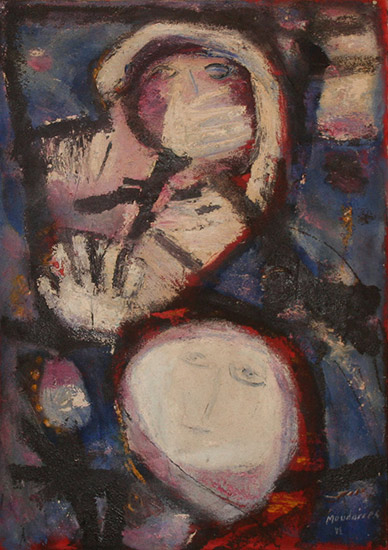Fateh Al Moudarres was a Syrian artist painter and a leader of the modern art movement in Syria. Initially self-taught, Moudarres later studied at the Accademia di Belle Arti in Rome, where he was influenced by Surrealism. After he completed his studies, he returned to Syria where he grew and honed his skills under the auspices of long-time friend, mentor, and tutor Wahbi Al-Hariri. Born in Aleppo, Syria, Fateh Moudarres originally taught himself realist techniques before becoming interested in Surrealism. He then studied at the Accademia di Belle Arti in Rome from 1954 to 1960 and developed a distinctive style of painting that incorporated both movements.
The heroes are taken both from the present and from ancient civilizations, and are both nameless peasants and legendary figures. Their square-shaped heads recall those of Assyrian statuary, and those of the figures in Palmyrene frescos, and also of early Christian iconography. These characters are enriched with warm and vibrant colors and executed in a variety of ways, sometimes with dense application of paint, sometimes scratched, or stippled, or with the addition of sand. Often a specific group of colors, such as red and black, or white and fawn, will dominate the painting.
Growing up Fateh Moudarres spent much time in the countryside, but the agricultural crisis of the 1960s forced him to relocate to Damascus. The city at that time was experiencing a period of unprecedented growth and fast becoming an increasingly cramped and hostile environment in which to live.
These conditions were compounded by the political and social unrest sweeping the Arab World. Against this backdrop Moudarres, along with several his artist contemporaries often sought to depict the everyday people and the problems they encountered. He was especially moved by the life of ordinary people in the Syrian countryside. For them, what on the surface, which can often incorrectly be characterized as an idyllic existence, was in fact a way of life marred by problems caused by social upheavals. The present composition depicts the life of the simple peasants, showing the country bride and wedding party.
In such a scene one might expect to see joyful celebration, but instead there is a palpable aura of sadness, as Moudarres reveals something of his feelings about suffering and helplessness of these women in the rural areas. Passed away in Damascus 1999.

